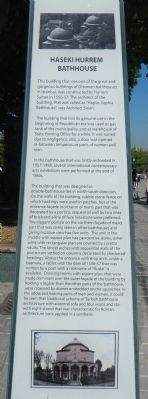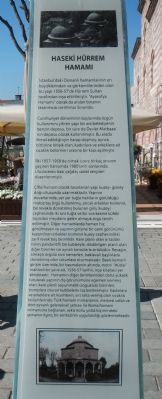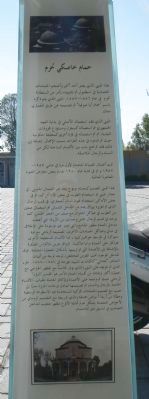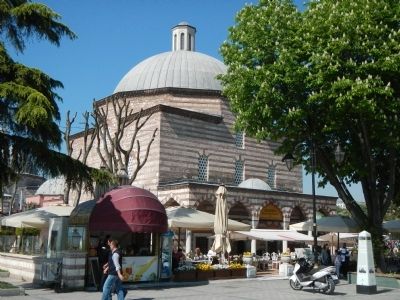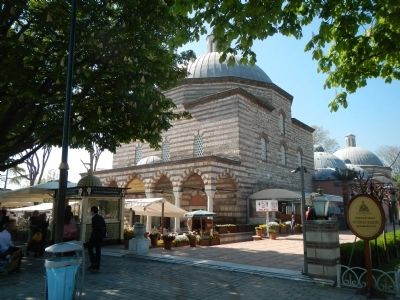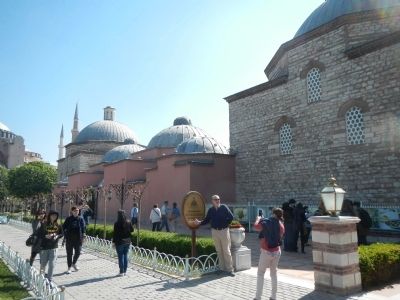Cankurtaran in İstanbul in Fatih, Turkey — West Asia or Southeast Europe
Haseki Hurrem Bathhouse
Haseki Hürrem Hamamı
This building that was one of the great and gorgeous buildings of Ottoman bathhouses in Istanbul, was constructed by Hurrem Sultan in 1556-57. The architect of the building, that was called "Hagias Sophia Bathouse", was Architect Sinan.
The building that lost its genuine use in the beginning of Republican era was used as gas tank of the municipality, and was warehouse of State Printing Office for a while. It was ruined due to negligence; also a door was opened in-between temperature parts of women and men.
In the bathhouse that was firstly restored in I957-1958, several international contemporary arts exhibitions were performed at the end of l980s.
The building that was designed as double-bathouse lies in north-south direction. On the walls of the building, rubble stone-fence on which hackings were used in patches, but at the entrance facade (northern) of men's part that was decorated by a portico, sequential wall by two lines of brick and a line of face limestone were preferred. The elegant portico on the northern facade of men's par that was rarely seen in other bathhouses and giving mosque view has five units. The unit in the middle with square plan has pendentive dome, other units with rectangular plan are covered by cavetto vaults. The lancet arches with sequential walls of the portico are settled on columns decorated by checkered headings. Above the entrance with drop arch, under a basmala, a tablet with the date of 1556-57 that was written by a poet with a nickname of "Hudai" is available. Dressing rooms with square plan, that were made dominant over the outer facade of the building by holding it higher than the other parts of the bathhouse were crowned by domes embedded on the squinches. In the addorsed heating parts of men and women, it could be seen that traditional scheme of Turkish bathhouse architecture with a central sofa and four iwans and star with eight-strand that was characteristic for Roman architecture were applied in a synthesis.
Turkish:
İstanbul'daki Osmanlı hamamlarının en büyüklerinden ve görkemlilerinden olan bu yapı 1556-57`de Hürrem Sultan tarafından inşa ettirilmiştir. "Ayasofya Hamamı" olarak da anılan binanın tasarımcısı ise Mimar Sinan'dır.
Cumhuriyet döneminin başlarında özgün kullanımını yitiren yapı bir ara belediyenin benzin deposu, bir süre de Devlet Matbaası'nın deposu olarak kullanılmıştır. Bu arada ihmal edildiği için harap düşmüş; ayrıca, birbirine bitişik olan, kadınlara ve erkeklere ait sıcaklık bölümleri arasına bir kapı açılmıştır.
İlki 1957-l958'de olmak üzere birkaç onarım geçiren hamamda l980'lerin sonlarında, Uluslararası bazı çağdaş sanat sergileri düzenlenmiştir.
Çifte hamam olarak tasarlanan yapı kuzey- güney doğrultusunda uzanmaktadır. Yapının duvarlarında, yer yer tuğla hatılların görüldüğü moloz taş örgü kullanılmış, ancak erkekler kısmının, bir revakla donatılmış bulunan giriş (kuzey) cephesinde iki sıra tuğla ve bir sıra kesme küfeki taşından meydana gelen almaşık örgü tercih edilmiştir. Diğer hamamlarda hemen hiç görülmeyen ve yapının girişine bir cami görünümü kazandıran erkekler kısmının kuzey cephesindeki zarif revak beş birimlidir. Kare planlı olan ortadaki birim pandantifli bir kubbeyle, dikdörtgen planlı olan diğer birimler ise aynalı tonozlarla örtülüdür. Revağın, almaşık örgülü sivri kemerleri, baklavalı başlıklarla donatılmış olan sütunlara oturmaktadır. Basık kemerli girişin üzerinde, bir besmelenin altında, metni "Hüdai" mahlaslı bir şaire ait, 1556-57 tarihli, inşa kitabesi yer almaktadır. Hamamın diğer birimlerinden daha yüksek tutularak yapının dış görünümüne egemen kılınmış olan, kare planlı soyunmalık (sogukluk) birimleri, tromplara oturan kubbelerle taçlandırılmıştır. Kadınlara ve erkeklere ait kısımların, sırt sırta vermiş olan sıcaklık bölümlerinde, Türk hamam mimarisinin, merkezi sofalı ve dört eyvanlı geleneksel şeması ile Roma hamam mimarisine bağlanan, sekiz kollu yıldız biçimindeki şemanın ilginç bir sentezinin uygulandığı gözlenmektedir.
Arabic: To read the Arabic text, click on the Arabic image to enlarge it.
Erected by Istanbul Büyükşehir Belediyesi (Istanbul Metropolitan Municipality).
Topics. This historical marker is listed in this topic list: Entertainment.
Location. 41° 0.434′ N, 28° 58.758′ E. Marker is in İstanbul, in Fatih. It is in Cankurtaran. Marker is on Ayasofya Meydanı close to Kabasakal Cadde, on the right when traveling east. Touch for map. Marker is at or near this postal address: Ayasofya Meydanı 10, İstanbul 34122, Turkey. Touch for directions.
Other nearby markers. At least 8 other markers are within walking distance of this marker. The Türbe (Tomb) of Sultan Mehmed III (about 90 meters away, measured in a direct line); The Türbe (Tomb) of Sultan Selim II (about 90 meters away); The Milion Stone (about 120 meters away); Million (about 120 meters away); Mausoleum of Sultan Ahmed I (about 150 meters away); The Basilica Cistern (about 180 meters away); Hagia Sophia (about 180 meters away); a different marker also named Basilica Cistern (about 180 meters away). Touch for a list and map of all markers in İstanbul.
More about this marker. The bathhouse is across the square from Hagia Sophia/Ayasofya.
Also see . . . Turkish bath - Wikipedia. The Turkish bath starts with relaxation in a room (known as the warm room) that is heated by a continuous flow of hot, dry air, allowing the bather to perspire freely. Bathers may then move to an even hotter room (known as the hot room) before they wash in cold water. After performing a full body wash and receiving a massage, bathers finally retire to the cooling-room for a period of relaxation. (Submitted on June 23, 2015, by Barry Swackhamer of Brentwood, California.)
Credits. This page was last revised on February 13, 2023. It was originally submitted on June 23, 2015, by Barry Swackhamer of Brentwood, California. This page has been viewed 416 times since then and 22 times this year. Photos: 1, 2, 3, 4, 5, 6, 7. submitted on June 23, 2015, by Barry Swackhamer of Brentwood, California. • Andrew Ruppenstein was the editor who published this page.
